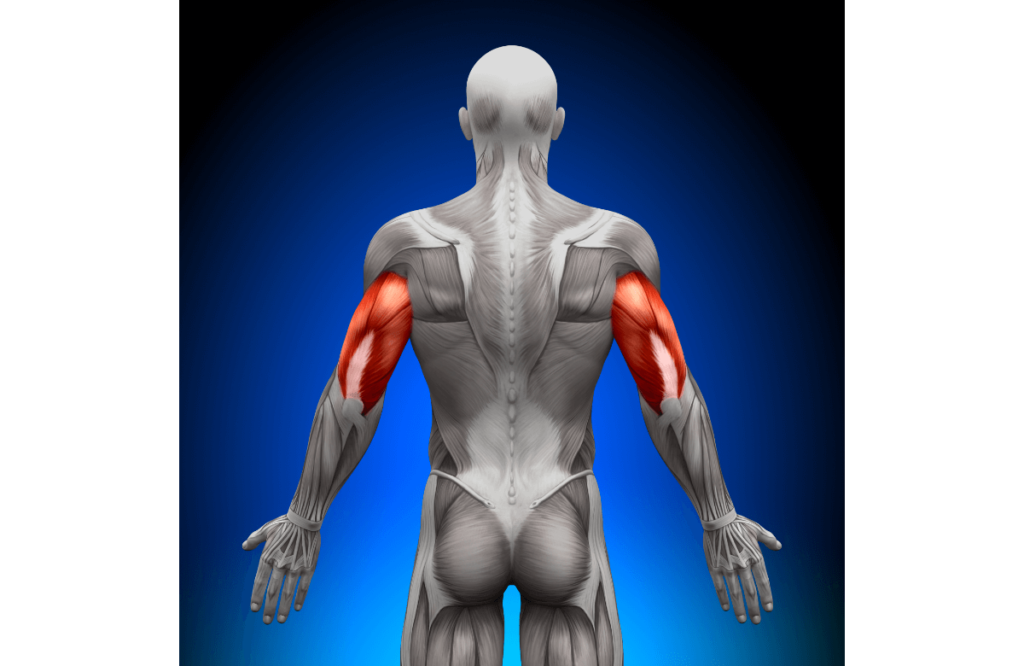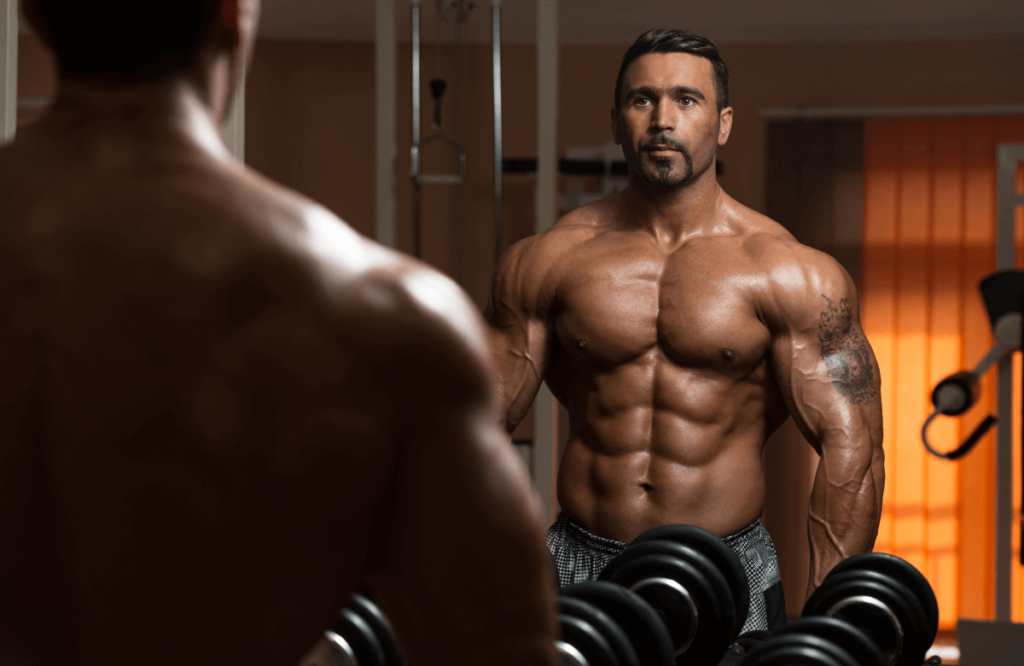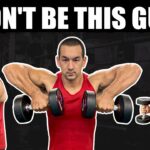We’ve all heard the saying, “Do curls to get girls” and it’s no secret that bigger arms can provide you with a more pleasing physique. More muscular arms also benefit day-to-day life, like lifting things overhead and carrying in groceries.
But what if you don’t have the time or equipment to get shredded?
That’s where our list of 11 dumbbell arm workouts comes in handy. These dumbbell exercises will challenge your muscles, helping you build strength and size in no time. Here’s everything you need to know.
Jump to:
Major Muscles in the Arms
When people look for arm exercises, they’re typically looking for movements to target the upper arm muscles. But technically, the arm is everything that hangs off the shoulder joint, including the forearms.
So, before you get down and dirty with a few hammer curls and lateral raises, it’s essential to understand basic anatomy.
A basic understanding of the arm muscles will help you identify which areas you want to target and how they work. More knowledge will help you select better exercises, address muscle imbalances, and develop more upper-body strength.
Biceps
The bicep muscles, or the biceps brachii, is located on the front of the arm. Biceps curls may come to mind when you think of arms training. The bicep has three distinct functions, including the following:
- Bending the elbow
- Turning the palm up
- Raising the arm forward

The bicep muscles have two muscle heads, hence the “bi” in the biceps. The two muscle heads are referred to as the long head and the short head.
The long head is found on the outside of the muscle and contributes to the peak of the muscle. You’ll find the shorter head on the bicep muscle’s inner section. It assists with bicep thickness and width.
Both portions work together, but adjusting your technique can engage one more than the other.
Triceps
The tricep muscle is located on the backside of the arm. This muscle has three different heads, including the long, lateral, and medial head. The main function of the tricep muscle includes the following:
- Extending the elbow joint
- Straightening the arm
- Involved in pushing movements

Strong triceps are critical for several exercises, as the tricep is a common secondary muscle for overhead and bench presses. Like the bicep, it’s possible to change which tricep head you engage depending on the exercise and technique.
Shoulders
The shoulder muscles, or deltoid muscles, are critical for arm movement, stability, and strength. The deltoid muscle is broken into three sections:
- Front anterior deltoid
- Side lateral deltoid
- Rear posterior deltoid

Each deltoid head has a specific function, contributing to various movements of the arm and arm strength.
- You use the front deltoid for dumbbell front raises or when you lift something in front of the body or throw an object.
- The side deltoid is used during lateral raises or when you lift the arm up and down.
- The rear deltoids help stabilize the shoulder and are activated when you pull the arm backward
Deltoid training will help with dumbbell arm exercises and assist with mobility, stability, and upper body size.
Forearms
The forearm muscles are often overlooked but critical for everyday activities. The muscle is broken into two groups, the anterior and posterior sections. Some of the muscles found in the forearm include the following:
- Brachioradialis
- Supinator
- Pronator teres
- Pronator quadratus
You use these muscles every day when you lift something, open a jar, or carry items. Forearm strength is helpful for several sports, like basketball and golf. Training these muscles can also help with grip strength, which can benefit other dumbbell exercises.

Why Use Dumbbells?
One of the main questions you might have is, “Why use dumbbells over barbell movements?”
Regardless if you only have a pair of dumbbells or have access to a total gym, dumbbell exercises have several advantages.
These exercises place less stress on the joints while addressing muscle imbalances and asymmetries. Dumbbell training is convenient, accessible, and offers versatility to suit nearly any fitness goal.
Easy on the Joints
Dumbbell workouts can have a broader range of motion compared to other pieces of gym equipment. This is because you’re not locked into a machine’s movement path or holding a barbell with both hands.
More range of motion allows you to position your arms differently to help with any discomfort. This can enhance joint mobility and flexibility, promoting better overall joint health and reducing the risk of injuries.
Address Muscle Imbalances
It’s common for one side of the body to take over during barbell movements. This can lead to muscle imbalances and technique issues.
One of the most significant advantages of dumbbell routines is the unilateral movement path, meaning you work on each side of the body independently. This helps you identify and correct muscle imbalances, ensuring symmetrical strength development and reducing the risk of compensation.
Extremely Convenient and Accessible
Not everyone has access to a gym or large pieces of equipment like a power rack. That’s where a pair of dumbbells can come in handy.
Dumbbells are smaller in size compared to other pieces of equipment, allowing you to store them in an apartment or small home. And if you don’t want multiple pairs of dumbbells hogging up your garage, you can always purchase adjustable dumbbells.
Not to mention, dumbbell routines can be performed in the comfort of your own home or at the gym. This makes them a fantastic option if you have a busy schedule, work from home, or can’t make it to the gym consistently.
Tons of Exercise Variations
The large amounts of exercise variation are another reason to work out with dumbbells. There are countless ways you can personalize your routine, like adjusting the weight, rep range, range of motion, and tempo.
Want to train for endurance and muscle hypertrophy? Use a pair of light dumbbells for higher reps with less rest. Want to build strength? Use heavier weights for a low amount of reps.
You can create custom routines or select exercises to suit nearly any fitness goal when you train with dumbbells.

Bicep Exercises
1. Dumbbell Curl
The Dumbbell Curl is one of the best movements for building the biceps. It’s an effective dumbbell exercise that’s easy to do, time-efficient, and delivers maximum results. As far as bicep curls go, this should be one of the staples in your routine.
How to perform the Dumbbell Curl:
- From a standing position with feet shoulder distance apart, grab a pair of dumbbells with an underhand grip. Allow your arms to hang by your sides.
- Raise the dumbbell with control to shoulder level.
- Do not allow your upper arms to move during the curl. Instead, maintain your arms at your sides, limiting the movement to your elbows.
- Lower the weight in a controlled motion to the starting position to finish one repetition.
Proper form is critical here, so avoid swinging your arms or jerky movement when lifting the weight. We recommend performing three sets of 8–12 reps.
2. Concentration Curl
The Concentration Curl requires you to focus on one bicep at a time, hence the name “concentration” curl. This unilateral variation reduces the chance of poor technique and jerky movements, allowing you to maximize your training. If you’re really in a rush, you can complete sets back-to-back without taking a break.
Here’s how to perform the Concentration Curl:
- Sit on a flat bench or seat with a dumbbell in your palm. Keep your feet flat on the ground and knees a bit wide.
- Take a slight lean forward and rest your elbow on your inner thigh.
- Take a deep inhale and curl the dumbbell up to your shoulder.
- Take a brief pause at the top of the curl before lowering the weight to complete one repetition. Finish all reps on that side before repeating the movement on the opposite side.
Remember, controlled movement is critical with arm curls. Pausing at the top of the training and lowering the weight slowly will also help with building arm strength. Perform three sets of 8–12 reps per arm.
3. Hammer Curl
The basic Hammer Curl might look similar to the other movement, but it has distinct advantages. The dumbbell hammer curl targets the long head of the muscle, helping you develop a more prominent peak. It will challenge your biceps and also add size to your forearms.
How to perform the Hammer Curl:
- Grab a pair of dumbbells using a neutral grip. Allow your arms to hang by the sides of your thighs.
- Now, raise the dumbbells to shoulder height in a controlled motion.
- Take a moment at the top and squeeze your bicep.
- Slowly lower the weight to the original position to finish one repetition.
- Repeat the technique on the opposite arm.
You should notice a squeeze in your muscles with the bicep curl position. Like the other techniques, avoid jerky movements and take your time to maximize results. We recommend performing three sets in the 8–12 rep range.
Tricep Exercises
4. Lying Triceps Extension
If you’re looking for an excellent dumbbell exercise, you need to try the Dumbbell Lying Triceps Extension.
This movement is fantastic for building the back and arms, as it targets all three tricep heads. You can perform this on a flat bench or on the floor, depending on your circumstances.
Here’s how to do the Lying Tricep Extension:
- Lie on your back using an exercise bench. Keep your head near the edge and grab a pair of dumbbells in both hands.
- Extend your arms straight up. Now, slowly lower the weights behind your head, bending at the elbows.
- Pause at the bottom of the movement before extending your arms to the original position. That’s one repetition.
All upper body movements require control, especially during the lowering phase. Aim to keep the same distance between your elbows when bending the weights behind your head. We recommend performing three sets of 10–15 reps.
5. Standing Dumbbell Triceps Extension
Overhead extensions are perfect for building size in your triceps. The Standing Dumbbell Triceps Extension is great for adding volume to your workout and can help you develop lean muscle mass. This is a unilateral movement, so it can also help with muscle imbalances, stability, and coordination.
Here’s how to execute the Standing Dumbbell Triceps Extension:
- Stand straight up with your feet shoulder distance apart. Raise a dumbbell straight over your head.
- Take a deep breath and keep your core tight.
- Now, slowly lower the weight behind your head. Keep your upper arm still and avoid jerky movements.
- Now, reverse the exercise to extend your arm back up and finish one repetition.
You can position your empty hand on your core to help with bracing and balance if necessary. Aim to perform three sets of 10–15 reps on each arm.
6. Tricep Kickback
The Tricep Kickback is an awesome dumbbell exercise for toning and developing the tricep muscle. The correct form can also benefit mobility, flexibility, and coordination in your arms. A lighter weight will help you focus on hypertrophy, endurance, and getting a nice pump.
How to perform the Tricep Kickback:
- Begin by standing with a dumbbell in each hand, your arms positioned down at your sides, and your palms facing inward.
- Keep your arms close to your body and slightly bend your knees. Take a slight lean forward at the waist.
- As you breathe out, straighten your arms, moving the dumbbells behind your body.
- Take a brief pause, and then bring your arms back to the original stance. That’s one repetition.
Remember to maintain a tight core and control during this exercise. Aim to complete three sets of 10–15 reps.
Shoulder Exercises
7. Arnold Press
One of the most effective arm exercises to engage all three delts is the Arnold Press. This movement was developed by Arnold himself and can be performed sitting or standing. The technique can be a bit complex at first, but you’ll see the benefits in no time.
How to perform the Arnold Press
- Take a seat on the weight bench while holding a dumbbell in each hand. Grasp the weights in front of your body, around face level, with your palms facing towards you.
- From this position, push the dumbbells directly over your head. While pressing the weights, rotate your wrists so your palms face away from your body at the highest point of the exercise.
- Once your arms are completely extended, slowly lower the dumbbells back to the original stance.
- Rotate your wrists again, ensuring they face your body at the end of the exercise.
- This completes one repetition. Repeat the exercise for your desired number of repetitions.
It’s best to practice control with overhead presses. Taking a brief pause at the top of the movement can make the Arnold Press more challenging, stimulating more muscle growth. We recommend performing three sets of 8–12 reps.
8. Front Raise
One of the most effective exercises for isolating the front deltoids is, of course, the Dumbbell Front Raise . Lighter weight is best here, as you want to focus on building endurance and hypertrophy. As always, brace your core and focus on control to get the most out of the exercise.
Here’s how to perform the Dumbbell Front Raise:
- From a standing position, grip a dumbbell in both palms. Rest the arms in front of your thigh with the palms facing your body.
- Slowly raise your arms straight up, keeping them straight. Raise the dumbbells until they reach shoulder level.
- Pause for a second before slowly lowering the weight to the starting stance to complete one rep.
- Slowly lift the dumbbells straight forward, keeping the arms straight. Lift the weight until you reach shoulder height.
You can raise one arm at a time to focus on your control, coordination, and stability. We recommend performing three sets of 10–15 reps per arm.
9. Lateral Raise
We can’t forget the side delts, and that’s where isolation movements like the Dumbbell Lateral Raise come in handy. This movement will enhance your shoulder stability and help you develop a broader upper body.
Here’s how to perform the Dumbbell Lateral Raise:
- Hold a pair of dumbbells in both palms. Keep your arms at the sides of your body with the palms facing toward the thighs.
- Gently raise the dumbbells out to your sides until they are just around shoulder height and parallel to the ground.
- Pause here for one count before slowly lowering the weight to the original position. That’s one rep.
Like the front raise, lighter weights are better here. Too much weight can place unnecessary stress on the shoulder joint and increase the risk of injury or strain. Aim to finish three sets of 10–15 reps per side.
Forearm Exercises
10. Palms-Up Curls
The Palms-Up Wrist Curl is fantastic for engaging the muscles on the underside of your forearms. This exercise can help with grip, hand, wrist, and forearm strength. It will also provide an excellent stretch for your arms.
How to do the Palms-Up Wrist Curl:
- Use 5–10 lb dumbbells or lighter.
- Take a seat on a chair or a bench. Grab the dumbbells with your palms facing the sky. Rest your forearms on your legs, allowing your hands to sit just on the edge of your knees.
- Relax your palms and slowly curl the weight upward, feeling a stretch in your wrist.
- Lower your hands to the starting stance to finish one rep.
Remember to use light weights here so you don’t place unnecessary strain on your wrist. If five pounds is too much, try 1.5–2.5. We recommend performing three sets of 10–15 reps.
11. Palms-Down Curls
The Palms-Down Curl is the same as the previous variation, but instead, you position your hands to face the floor instead of the sky.
Similar to the upward variation, this wrist curl works the top of your forearm instead of the bottom. This will provide you with well-rounded forearm development, ensuring you engage both portions of the muscle.
We recommend lighter weights for this exercise, as too much can be painful and increases the chance of strain. We recommend completing three sets of 10–15 reps.
Training Tips
We covered a few exercises for each muscle group, but you’ll need some additional tips to take your dumbbell training to the next level. Here are a few considerations to keep in mind before starting your routine.
Gradually Increase Weight and Intensity
As you become stronger, use progressive overload to continuously challenge your muscles. This means gradually increasing the weight as you get stronger and stronger.
Gradual increments in weight allow for steady progression and prevent plateauing. However, be sure to maintain proper form and avoid sacrificing technique for heavier weights.
Focus on Form and Range of Motion
Prioritize proper form and full range of motion in each exercise. This ensures you are effectively targeting the muscles and minimizing the risk of injury.
Avoid swinging or using momentum to lift the weights, and concentrate on controlled movements. Taking a pause at the top of exercises and practicing control will challenge your muscles more, leading to more growth.
Prioritize Recovery and Rest
Give your muscles time to recover and rebuild by incorporating rest days into your training schedule.
Adequate rest and recovery are essential for muscle growth and preventing overuse injuries. Additionally, consider incorporating stretching exercises or foam rolling to help alleviate muscle soreness and maintain flexibility.

Frequently Asked Questions (FAQ)
Can I Build Arms With Dumbbells?
Yes, dumbbells are an excellent tool for developing arm strength and size. You can use different exercises to target every muscle in the upper body, including the biceps, triceps, shoulders, and forearms.
What Size Dumbbells for Flabby Arms?
If you’re just starting out, we recommend using moderate weights. For men, this might be 10–20 pounds and 5–10 pounds for women. If this is too light, try increasing the weight by 2.5–5 pounds. The right weight will allow you to complete exercises getting close to failure at the end of each set.
How to Do a Full Arm Workout With Dumbbells?
A full arm workout will engage the biceps, triceps, and shoulders. It’s best to include 1–2 exercises per muscle group, depending on your goals, experience level, and time constraints. A bicep curl, tricep extension, and overhead press variation can engage your entire arm.













